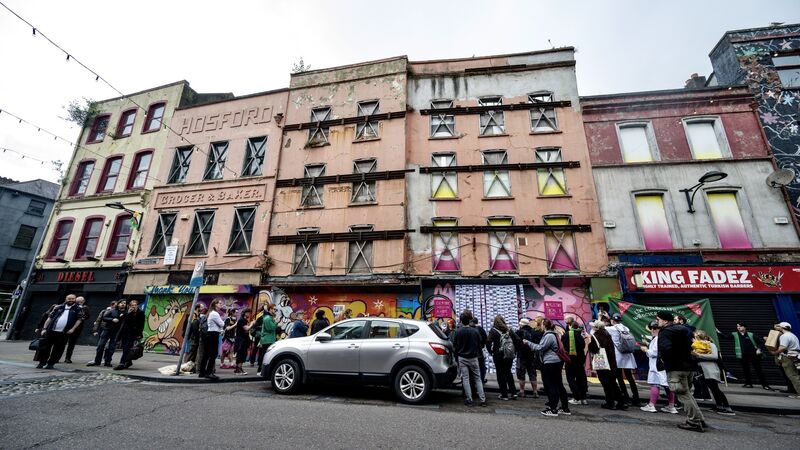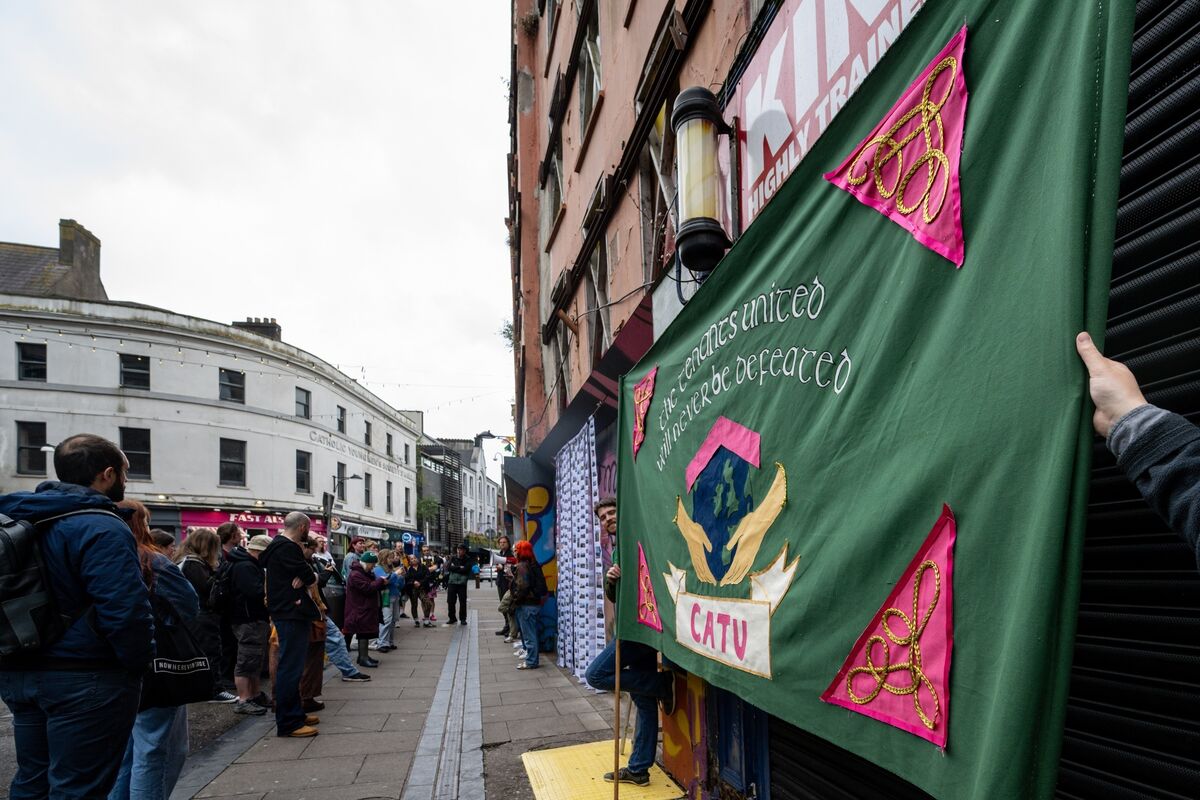We're going to war on dereliction — but not yet

Protesters outside a derelict building on North Main Street in Cork City during an anti-dereliction demonstration in June. It took the Government three years to listen to us then, we hope they will be quicker to act this time. Picture: Chani Anderson
You may have missed it but hidden in the ‘austerity in boom-time’ budget is a small but very significant technicality that will see Revenue collecting and renaming the 35-year-old Derelict Site Levy, from now on known as the Derelict Property Tax.
Finally, the Government is giving teeth to what has been an ineffective and largely ignored levy. This represents the first shot fired in the housing minister James Browne’s declared ‘War on Dereliction’. It’s a radical shift in how serious the Government is in tackling dereliction, and fair to say would not have happened if not for public pressure through the nationwide grassroots #DerelictIreland movement.
There is no doubt that this relatively small but radical transfer of responsibility from the local authorities to Revenue will have a very positive impact on both urban and rural Ireland.
Councils have been notorious in their inability to register properties and collect the dereliction levies with only 10% of the levies collected in 2023 (€604,621 out of €5.6 million invoiced), and a total of €20.5 million currently outstanding. These collection rates pale in comparison to the 95% collection rate for the Local Property Tax (LPT) that Revenue is also responsible for collecting.
By increasing the registration and collection rates of the derelict property tax, additional funding will be available for councils to bring their own 2,749 empty homes back into use more quickly, as well as building new council homes on public land.
Any surplus funding collected from the derelict property tax should be used by councils to enhance public luxury through creating more liveable towns and city centres, such as much-needed public playgrounds, toilets, parks, bins and benches.
First introduced in 1990, the levy was a 7% fine supposed to be placed on all derelict sites and buildings. It has been announced that the new tax will also be at least 7%.
This all sounds positive until you realise that there is no commitment by the Government on when the new tax enforcement will happen, with early indications that they could delay this new derelict property tax by at least three years.
Apparently, councils need two more years to compile and publish a registry of all the derelict properties in their areas, despite having had 35 years to do this, and despite many already having a register.
Due to pressure from #DerelictIreland community groups (eg Drogheda Vacancy & Dereliction Taskforce and Sligo Housing Action Group) some councils have increased the number of derelict properties registered, while Dublin has increased registrations by 80% in the last four years.
However, the overall national average is only a 23% increase in derelict registrations between 2020 and 2023 (from 1,548 up to 1,913).

Anyone who has followed the #DerelictIreland movement over the last five years will not be surprised that the existing derelict sites registries are woefully incomplete. So how can we expect the councils to get a complete register in the next year?
To do this we need to look beyond the existing council registrations. There are other datasets that could be used. Datasets that us taxpayers have already paid for.
For example, Revenue already has a list of the derelict homes that have claimed exemption from LPT for being uninhabitable, while GeoDirectory has the addresses of 19,821 derelict homes they identified in Q2 2025. Likewise, the Central Statistics Office using data from the ESB should have lists of properties that have been disconnected from electricity, a strong indicator of dereliction.
Our recommendation is to task Revenue with combining all of this data with the existing derelict sites registers to create a new derelict property register. This should happen between now and January 2026. The new derelict property tax can then be enforced immediately.
In doing so, the Government must learn from the mistakes of the residential zoned land tax, which was meant to replace the ineffective vacant sites levy, as well as the vacant homes tax, which we predicted was designed to fail in an Irish Examiner piece in 2022. And fail it did, having been applied to only between 1.5% to 3.7% of the vacant homes in the country.
Yet vacancy is the gateway to dereliction.
In essence, we are calling on the Government to introduce a robust, accurate and updatable registration of all homes that fall into one of these three states: in use; vacant; or derelict. Revenue already asks if a home is your primary residence in LPT submissions. Why not expand these questions to include other data?
This new Revenue home registration system should then connect in with the very generous Croí Cónaithe grant, which sees owners of vacant and derelict homes get between €50k-70k. We believe the vacant homes tax and the derelict property tax should be covering the costs of these grants.
So far, there has been €155 million paid out since Croí Cónaithe was first introduced in 2022. This is significantly more than the €3.9 million collected from the Vacant Homes Tax in 2023 and 2024 or even the €20 million owed on the derelict sites levy. With 10,000 more successful Croí Cónaithe applications waiting to be paid out, this gap between carrot and stick is only going to widen.
It’s important to remember that taxes on their own will never be an effective deterrent. The affluent can just pay the taxes while retaining ownership of their dangerous derelict wealth assets.
Therefore, we also need more direct measures such as Compulsory Sales Orders (CSO) as applied in Scotland and England and Compulsory Rental Orders (CRO) as applied in Amsterdam and Barcelona.
These could be introduced in Ireland to bring habitable vacant homes back into use or see derelict properties placed on to the market so a new more responsible owner can bring them back into use with help from the Croí Cónaithe grants.
This is what we will be telling the Joint Committee on Housing, Local Government and Heritage in the Oireachtas when we present to them on October 21.
In 2021, we advised a similar Oireachtas Committee to get Revenue collecting the derelict sites levy. It took the Government three years to listen to us then.We hope they will be quicker to act this time. People’s lives and our social cohesion are at risk.
As always, we live with dóchas.
- Jude Sherry and Dr Frank O’Connor are the co-instigators of the #DerelictIreland movement and co-founders of anois and ffud.















